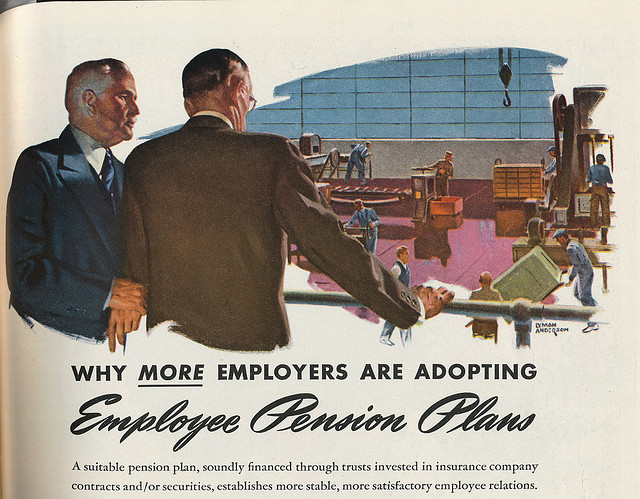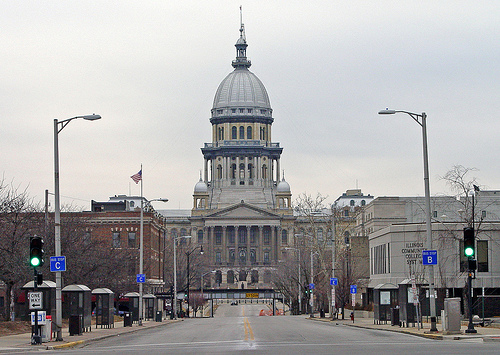Why don’t most Illinois teachers receive Social Security?
By Tony Arnold

Why don’t most Illinois teachers receive Social Security?
By Tony ArnoldIllinois’ stack of unfunded pension obligations stands at $96 billion, according to Gov. Pat Quinn’s office. It’s a political predicament that’s soaked up Springfield’s attention for the better part of 2012, in part because the state’s pensions are the worst-funded among every state in the country. The talk surrounding the issue has ranged from the deadly serious (the governor said earlier this year that he was “put on this earth to get [pension reform] done”) to the downright unusual (check out Squeezy the Pension Python, not to be confused with Kaa in The Jungle Book).
It’s in this context that Milt Walp asked a timely question about history:
Why do government workers in Illinois have their own pensions program and not pay into Social Security, which is run by the federal government?

In talking with Milt, he said his question was partly inspired by his own experience: Like all Chicago Public School teachers, he doesn’t pay into Social Security. Given that, my editor Shawn Allee suggested I narrow our investigation and, with Milt’s blessing, I focused solely on why so many Illinois teachers don’t pay into the federal system. For those of you who voted for this question in a Curious City voting round, you should know that I’ll be digging into the pensions issue deeply in the next few weeks, as the legislature’s lame-duck session approaches. I’ll consider opportunities to explain why other state workers also don’t participate in the federal system.
If it ain’t broke …
Anyway, the short answer is that when it comes to retirement security, Chicago teachers in particular beat the Social Security system to the punch; the Chicago Teachers’ Pension Fund was created in 1895, making it one of the oldest pension systems in the country. The feds, though, took until the 1930s — four decades later — to create Social Security. But even after Social Security was in place, it was still a work in progress; by the 1950s the federal government expanded the program, opening it to new classes of state and municipal workers.
At this point Chicago teachers had the option of joining, too, but they took a pass. Why? Kevin Huber, the current head of the Chicago Teachers’ Pension Fund, says most people involved in the teachers’ pensions (whether it be the pension fund board trustees or the teachers themselves) felt that they already had a good thing going.

The logic is similar for teachers outside Chicago. The Illinois Teachers’ Retirement System, or TRS, was created in 1915 to cover teachers in the suburbs and downstate Illinois.
“The decision was made that teachers would stay out of Social Security because Teachers’ Retirement System was providing a comparable benefit to the federal Social Security plan,” says Dave Urbanek, a spokesman for TRS. “And that’s basically the way it’s continued until this day.”
Urbanek says he hasn’t seen much documentation examining the decision not to join Social Security because he’s not sure teachers ever clamored to get in. The Teachers’ Retirement System would’ve had to fill out some forms to get into Social Security, but it wouldn’t have had to document its decision to keep things as they were.
The beauty of Milt’s question is that it forces us away from the current hullabaloo over Squeezy the Pension Python (from the video above) or dust-ups between formidable political players (e.g., Gov. Pat Quinn and legislative leaders from both sides of the political aisle). Instead, it gets to something more fundamental: In the 1950s both teachers and the employers (the state and Chicago Public Schools paid into the system) preferred their own systems over Social Security. What led them to keep striking their own deals rather than take up a New Deal program?
Social Security, the underdog
The quick and dirty reason: the overall payout. “The Chicago Teachers’ Pension Fund is a lot better than Social Security,” says Huber. “Better investments, more well-managed (sic).”
The two systems — one for Chicago and another for the rest of Illinois public school teachers — operate differently, but they both benefit the retiree compared to Social Security. For example, in TRS, teachers contribute the equivalent of 9.4 percent of their salary, and the school district contributes the equivalent of .58 percent. But Urbanek says there’s another player here: the state of Illinois, which he says chips in the equivalent of 28 percent of the teacher’s salary. All told, then, an Illinois teacher outside Chicago that participates in this program has the equivalent of 38 percent of his or her salary put aside.
Where does Social Security stand? Under that system, both the employer and the employee contribute 6.2 percent of income, for a 12.4 percent total set-aside. Even if you don’t account for Social Security’s lower payout, the lower total set-aside alone puts it at a disadvantage. The details and formulas governing each system have changed over the years, obviously, but on the main the federal program was never an attractive alternative.

But Huber goes on to explain another reason other than just higher returns, one that involves the state’s, um, “flexible” contribution.
“Problem is, it [the pension fund] is not as well-funded, right?” Huber says. ‘Social Security, you can’t avoid the federal government. You can’t avoid the tax man. Our friends in Springfield have figured out how to avoid the pension man.”
That is, the federal government actually enforces policies that ensure both employers and employees contribute to Social Security. Teachers’ pensions work differently, though. Springfield is not in the habit of collecting on its own obligations to TRS, and no one’s effectively pushed the issue at the Chicago school system, either. Hence, Huber says that the Chicago Board of Education didn’t contribute to the teachers’ pension fund from 1995-2005 and that state funding meant to help the fund didn’t come through. He says this is one reason why the Chicago Teachers’ Pension Fund was about 60 percent funded in the 2011 fiscal year.
Better, but with a big caveat
If Illinois teachers or governments that pay into teachers’ pension systems changed their minds and wanted to flee into the arms of Social Security, they’d have a rude awakening.
Laurence Msall of the Civic Federation, a Chicago-based fiscal watchdog group, says CPS is supposed to pay more than it would under the federal system. The problem is that, in practice, it’s sometimes paid almost nothing at all, and it’s fallen behind in its obligations. If the Chicago teachers’ pension system would disappear, CPS would likely have to pay into Social Security and, as we said above, you can’t avoid the tax man so easily.

The problem, Msall says, is how untenable the current situation is: If the state and CPS don’t make their contributions and the pension systems aren’t fully funded, there may not be enough to pay every retiree.
So, getting back to Milt’s question, part of the answer of why Illinois teachers don’t pay into Social Security is that they’ve had “better” deals, but lately these deals come in the context of dodged payments on the part of their employers. So, the real answer can’t just boil down to a strict numbers game; it has to do with trust, too. So far, teachers’ pension systems have trusted that the state of Illinois and Chicago Public Schools will eventually pay enough to cover pension obligations. That’s despite questions about who will pick up the pension tab while also balancing payments with other public goods, such as education, roads, parks and public safety.


